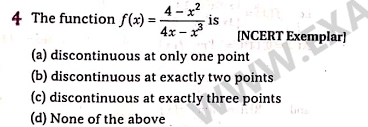Full solution
Q. The function is(a) discontinuous at only one point(b) discontinuous at exactly two points(c) discontinuous at exactly three points(d) None of the above
- Factorize Denominator: To find the points of discontinuity, we need to determine the values of for which the denominator of the function becomes zero, as these will be the points where the function is undefined.The denominator is . We can factor out an to simplify it:
- Set Denominator Equal to Zero: Now we set the factored denominator equal to zero to find the values of that cause the function to be undefined:This gives us two equations to solve:) )
- Solve for : Solving the first equation is straightforward: This is our first point of discontinuity.
- Solve for and : Solving the second equation:Taking the square root of both sides gives us two solutions: and These are our second and third points of discontinuity.
- Final Discontinuity Points: We have found three points of discontinuity for the function , which are , , and . Therefore, the function is discontinuous at exactly points.

